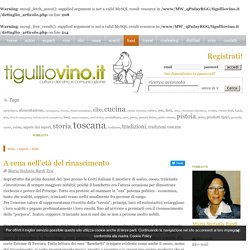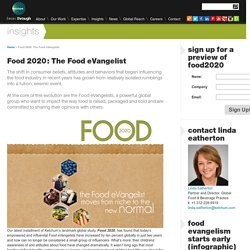

A cena nell'età del rinascimento, di Maria Stefania Bardi Tesi. Soprattutto dai primi decenni del '500 presso le Corti italiane il mestiere di scalco, cuoco, trinciante s'investirono di sempre maggiore nobiltà; poiché il banchetto era l'attesa occasione per dimostrare ricchezza e potere del Principe.

Tutto era proteso ad osannare la "sua" potenza politica - economica, tanto che scalchi, coppieri, trincianti erano scelti usualmente fra persone di rango. Per l'enorme valore di rappresentanza rivestito dalla "tavola"; principi, laici ed ecclesiastici vezzeggiano i loro scalchi e pagano profumatamente i loro cuochi, fino ad arrivare a premiarli con il riconoscimento della "porpora". Scalco, coppiere, trinciante non si suol dar se non a persone molto nobili. E così nemmeno il cuoco preso dalla cultura umanista, sfugge alle suggestione del mondo antico.
Dalla descrizione dei banchetti offertaci da Messisbugo appare inoltre evidente il particolare galateo della tavola cinquecentesca. CorradoT: Sei ricette del Rinascimento. (Immagine dalla rete) Piccola nota storico-gastronomica - Il Rinascimento e' posteriore al Medioevo: mentre questo termina verso il 1350 i Rinascimento va dal 1350 a tutto il 1600.

Dal punto di vista gastronomico la cucina medioevale faceva largo uso di carni e spezie, anche dolci. Il sale era usato raramente. Nel Rinascimento si continuano ad usare le spezie note nel Medioevo, ma si cominciano ad usare le verdure. Le tecniche di cottura si fanno piu' raffinate.Sull'uso delle spezie: erano indispensabili, in quanto non esistevano i frigoriferi e i cibi deperibili, ebbene, deperivano. Qui nel seguito troverete alcune ricette, recuperate ed adattate. Le ricette che troverete descritte, come quasi tutte le altre del Rinascimento, sono giunte fino a noi tramite vecchi scritti o addirittura per trasmissione orale.
Notato che in questa ricetta non si fa uso di sale? Ketchum food 2020 infographic jan. 2016. Food 2020: The Food eVangelist. Our latest installment of Ketchum’s landmark global study, Food 2020, has found that today’s empowered and influential Food eVangelists have increased by ten percent globally in just two years and now can no longer be considered a small group of influencers.

What’s more, their childrens’ awareness of and attitudes about food have changed dramatically. It wasn’t long ago that most families defined healthy eating simply as having a balanced meal and children had little say about the food that was prepared for them. Those days are gone. Consider this: 49% of all parents surveyed say their children take an active role in choosing the types of food the family eats39% of all parents surveyed say their children look at labels38% of all parents surveyed say their children shun foods with certain ingredients So, what does the rise of the Food eVangelist mean to those responsible for advising leadership, leading businesses and building brands?
Dolcesalato La prima rivista dell’eccellenza artigianale. Rivista di Cucina e Alimentazione - Il Giornale del Cibo. Piaceri Mediterranei (@PiaceriMed) Prodotti senza glutine. Tiziana colombo (@laNonnaPaperina) About ECF. Accueil - AIBI. AIIPA - Associazione Italiana Industrie Prodotti Alimentari. AIJN. EU Fish Processors Association / EU Federation of national organisations of Importers and Exporters of fish.
AMITOM - Association Méditeranéenne Internationale de la Tomate - Mediterranean International Association of the Processing Tomato. Associazione Italiana industrie Prodotti ed Integratori Alimentari Integratori e Benessere. Culinaria Europe e.V. - Welcome to CULINARIA EUROPE! FEDERSALUS - Home. Food Supplements Europe. Global Information, Science and Regulation. International federation of fruit juice producers. Istituto Superiore di Sanità: Benvenuti. European Organisation of Tomato Industries.
THE EUROPEAN ASSOCIATION OF FRUIT AND VEGETABLE PROCESSORS. The European Food Information Council (EUFIC) : La tua guida su sicurezza alimentare, qualità dei cibi, salute e nutrizione per una dieta bilanciata e uno stile di vita sano. Sugars, a type of carbohydrate, have been making media headlines repeatedly over the last years.

Most strikingly, the debate tends to be based on gut feelings rather than solid science, often missing out on key studies and reviews. However, for policy makers to make informed decisions about sugar consumption in relation to health, they require a well-balanced reflection of the current scientific evidence. In this context, the European Food Safety Authority in its 2010 scientific opinion on dietary carbohydrates concluded that current data do not allow setting an upper limit for (added) sugar intake in relation to body weight, dental health and certain adverse metabolic effects.
Sugar is a common and important part of our diet and provides an essential fuel for our bodies. In fact, the brain and the red blood cells need glucose as an energy source since they cannot use fat, protein, or other forms of energy for this purpose. Leggi altro. What's New.